ISSN ONLINE(2319-8753)PRINT(2347-6710)
ISSN ONLINE(2319-8753)PRINT(2347-6710)
Darshan M. Katgeri1, Anand V. Kulkarni2, Sachin C. Kulkarni3
|
| Related article at Pubmed, Scholar Google |
Visit for more related articles at International Journal of Innovative Research in Science, Engineering and Technology
The objective of this study is to develop a better understanding of the effects of spindle speed (S), cutting feed rate (f) and depth of cut (d) on power consumption and to build a suitable mathematical model. Such an understanding can provide insight into the problems of estimating the power requirements of machined surfaces when the process parameters are adjusted to obtain a certain responses like power consumption. This paper aims at presenting the techniques that can be employed to predict the effect of speed, feed and depth-of-cut to generate information that will allow us to understand and model the relationship between the process variables and measures of the process performance
Keywords |
| Orthogonal Array (OA), Taguchi, Regression, Power Consumption |
INTRODUCTION |
| Machining is one of the most important activities in manufacturing. It is of great importance not only to the machine tool industries but also to the entire class of engineering manufacturing industries using machine tools in one form or the other. Although extensive research has been done in this field the metal cutting industries using various machine tools continue to suffer from a major drawback of not utilizing the machine tools at their full potential; in order to address this problem various parameters that affect this problem have to be analysed. One way of doing this is to carefully design an experiment that will allow us to measure the process parameters using experience and knowledge. Design of Experiments is a tool to develop an experimentation strategy that maximizes learning using a minimum of resources. Most of the standard experimental designs can be generated once the experimental objective, the number (and nature) of the design variables, the nature of the responses and the economical number of experimental runs have been defined. Generating such a design will provide the user with the list of all experiments to be performed in order to gather the required information to meet the objectives. With designed experiments there is a better possibility of testing the significance of the effects and the relevance of the whole model. The concept of using OA’s to design an experiment was first introduced by Taguchi. |
| The general machining problem can be described as the achievement of a predefined product quality with given equipment, cost and time constraints. This paper aims at presenting the techniques that can be employed to predict the effect of speed, feed and depth-of-cut to generate information that will allow us to understand and model the relationship between the process variables and measures of the process performance. Well-chosen experimental designs maximize the amount of information that can be obtained for a given amount of experimental effort and might lead to a more rapid solution. |
| Carbon steel EN-24 and EN-31 have been selected due to their commercial use in industry. Machining is carried out on Kirloskar lathe. The experiments have been carried out according to Taguchi’s L9 array. Minitab statistical analysis software has been used to obtain design matrix, propose the regression equation and obtain graphs of main effect, interaction effect and perform Taguchi’s S/N analysis. The effect of used petrol engine oil (SAE-40) on power consumption of EN-24 and EN-31 is studied. |
| The predicted model mainly depends on critical parameters like spindle speed, feed rate, depth of cut and their interaction among each other. This allows for the determination of optimal machining strategies and tooling for the required machining processes. The resulting benefits will allow for the machining process to become more productive and competitive. |
| Bhattacharya et al [1] investigated the effects of cutting parameters on power consumption by employing Taguchi techniques. Their results showed a significant effect of cutting speed on the power consumption, while the other parameters did not substantially affect the responses. The literature survey reveals that traditional experimental design procedures are too complicated and not easy to use. A large number of experimental works have to be carried out when the number of the process parameters increases. To solve this problem, the Taguchi method uses a special design of orthogonal arrays to study the entire parameter space with only a small number of experiments [2]. Lin [3] has formulated the experimental results of surface roughness and cutting forces by regression analysis, and modeled the effects of them in his study using S5SC steel. Sood et al [4] studied the specific energy where the power of machining is one of the parameter affecting the specific energy. Faleh et al [5] have reported that the power consumption is one of the most important parameters for online monitoring of tool conditions. It is can be seen that power consumption is increased with increase in cutting speed, feed rate and depth of cut. This is quite obvious because as all this three parameters increases, the material removal rate also increase which forcing the system to spend more power. |
| Based on the experiment and the analysis it is observed that used petrol engine oil (SAE 40) reduces the power requirement during machining. |
| Paper is organized as follows. Section II describes the Methodology. Section III describes the experimentation and selection of factors, levels and OA’s. Section IV focuses on the power consumption. Section V deals elaborately with the results obtained and the mathematical equations used to predict the power consumption. The main effects plot and the interaction plot are shown in this section. Finally, Section VII presents conclusion. |
II. RELATED WORK AND METHODOLOGY |
| The literature survey reveals that there is lot of scope for research and exploration in the area of power consumption. Hence power consumption is selected as the output parameter. A thorough study on machining and of Taguchi methodology was done and then the input and output parameters were selected. An L9 orthogonal array was selected though the resolution of this orthogonal array is low. The predicted values are in close match with actual values of power consumption and the results are within 90% confidence level. |
| The steps mentioned below are followed as guidelines to design and conduct the experiment. |
| 1. Define the process objective. |
| 2. Determine the design parameters affecting the process. Parameters are variables within the process that affect the performance measure such as speed, feed, depth of cut etc. that can be easily controlled. |
| 3. Create orthogonal arrays for the parameter design indicating the number of columns and conditions for each experiment. The selection of orthogonal arrays is based on the number of parameters and the levels of variation for each parameter. |
| 4. Conduct the experiments indicated in the completed array to collect data on the effect on the performance measure. |
| 5. Complete data analysis to determine the effect of the different parameters on the performance measure. |
| 6. Conduct conformation and validation experiments to confirm the accuracy of prediction of the proposed regression equations. |
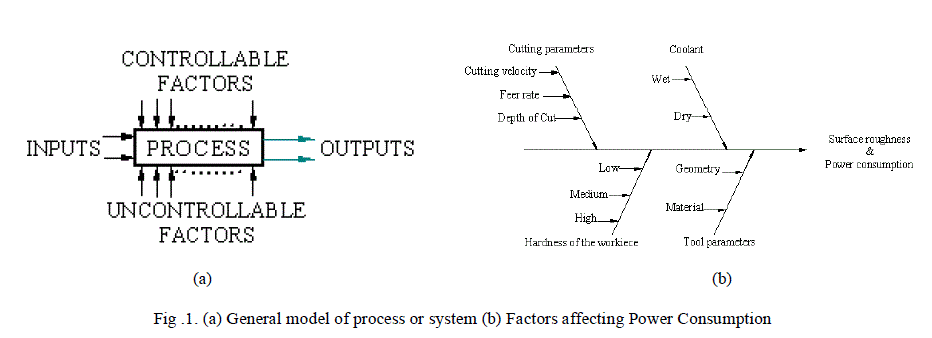 |
III. EXPERIMENTATION AND SELECTION OF FACTORS, LEVELS AND ORTHOGONAL ARRAY |
| In this study, work pieces of steel EN-24 and EN-31 of dimensions ïÃÆÃâ 20 X 70 mm are used. The machining was carried out on a Kirloskar lathe using single point carbide tool. The experiments were conducted for both dry and lubricated (wet) conditions; used petrol engine oil (SAE-40) was utilised as lubricant, sufficient oil was smeared all-round the work piece using a brush. The factors chosen for the experiments are speed (S), feed (f), and depth of cut (d). Level 1 represents low level, Level 2 is the intermediate level and Level 3 is high level; for Level 1 speed, feed and depth of cut are 630(m/min), 0.08(mm/rev) and 0.5(mm) respectively. The values for Level 2 & Level 3 are given in Table 1. |
 |
| To select an appropriate orthogonal array for experiments, the total degrees of freedom need to be computed. The degrees of freedom are defined as the number of comparisons between process parameters that need to be made to determine which is better and specifically how much better it is. A three level process parameter counts for two degrees of freedom. The degrees of freedom associated with interaction between two process parameters are given by the product of the degrees of freedom for two process parameters. In this study an L9 orthogonal array is used. Each cutting parameter is assigned to a column. The design matrix was generated using Minitab V14. Table 2 represents the coded values of the factors. The values 1, 2 and 3 represents low level, intermediate level and high level. These values correspond to the values given in Table 1. |
 |
IV. MACHINING PERFORMANCE MEASURES |
| Power Consumption is used such as a measure of machining performance. The equation for the power isP = Fc * V, where P is the power in watt, V is the cutting speed in m/min and Fc is the main cutting force in N. The power is dissipated mainly in the shear zone (due to the energy required to shear the material) and on the rake face of the tool (due to tool-chip interface friction). |
V. EXPERIMENTAL RESULTS |
| The experiments have been performed on EN-24 and EN-31 materials in accordance with the design matrix obtained earlier.The main effects and the Interaction plot have been plotted using Minitab V14. The graphical comparison of power consumption for both the materials under dry and lubricated condition is done using MS Excel.Table 3shows the tangential force F(tan), feed force F(feed), and radial force F(rad), resultant of the forces, experimental value power consumption and the predicted value of power consumption for EN-24 under non lubricated conditions.The experimental values are obtained by using the equations given below. |
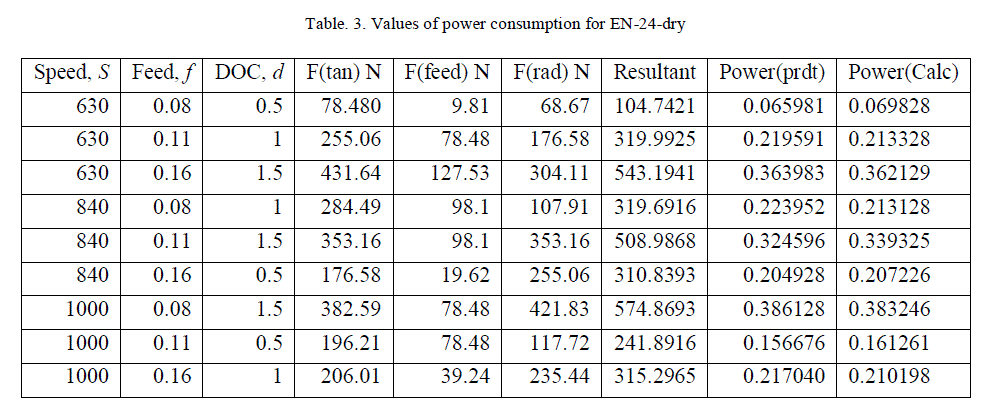 |
| Fig 1. (a) shows that the power consumption increases between speed range 630 to 840 and remains constant thereafter; it increases gradually with feed and DOC. Fig 1 (b) shows the interaction plot of Speed v/s Feed, Speed v/s DOC, and Feed v/s DOC. At medium and high speeds and high feed rate the power consumption is almost same. The lowest power consumption is observed at low speed and low feed as expected. It is recommended to use medium DOC to get optimum power consumption. Lowest power consumption is obtained at low speed and low DOC and highest power consumption is obtained at high speed and high DOC as expected. The power consumption is observed to increase with increase in feed and DOC, at medium DOC the power consumption is same for all feeds. It is recommended to use medium DOC to get optimum power consumption. |
| Predicted regression model for power consumption is |
| Power (prdt) dry = -0.7760 + 0.000779S +7.773f +0.2198d -0.007245Sf +0.000105Sd -1.2232fd +0.000472 |
| Table. 4 gives the forces, resultant and the values of power consumption obtained in turning EN-24 under lubricated (wet) condition. The resultant is the square root of the sum of squares of all the forces. |
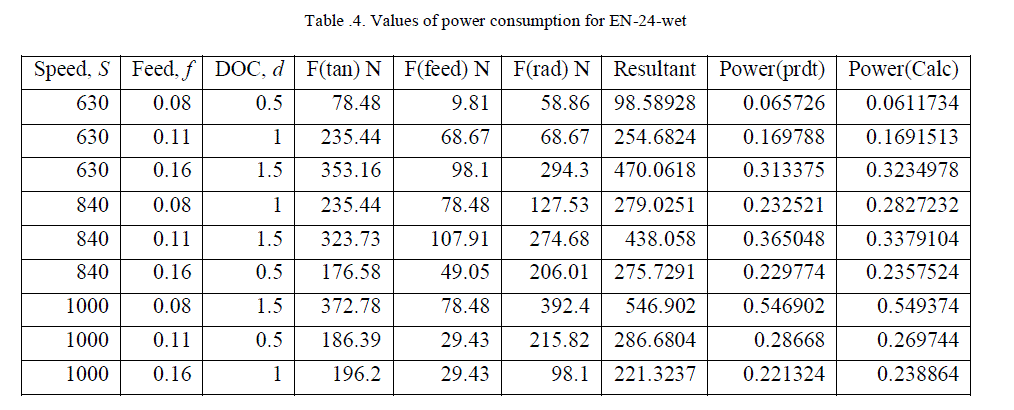 |
| Fig 2. (a) shows that the power consumption increases as speed increases; it gradually decreases as feed rate increases. There is no much change in power consumption from DOC 0.5 to 1.0 mm but then after it increases drastically. Fig 2 (b) that the unit variation of power consumption for all speeds and low feed rate is much pronounced and it is observed to decrease at medium feed rate, the unit variation is lowest at highest feed rate. At medium and high speeds and high feed rate the power consumption is almost same. The lowest power consumption is observed at low speed and low feed as expected. The power consumption is observed to increase with increase in speed and DOC, at medium DOC the power consumption is almost same for speeds 840 and 1000.At medium DOC the power consumption is same for all feeds. It is recommended to use medium DOC to get optimum power consumption. Lowest power consumption is obtained at low feed and low DOC and highest power consumption is obtained at low feed and high DOC. |
| Predicted regression model for power consumption is |
| Power (prdt) wet= -1.3635 + 0.001761S+ 13.755f-0.2683d -0.015839Sf +0.000517Sd -0.486fd +0.003864 |
| Table. 5 gives various values of forces and power consumption obtained during experimentation of EN-31 under non lubricated conditions.The table also shows predicted and experimental values. |
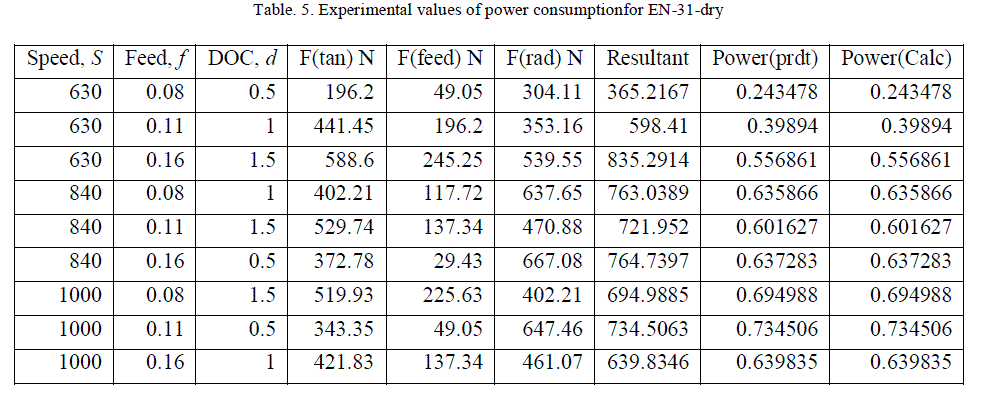 |
| Fig 3. (a) shows that the power consumption increases gradually as the levels of all the factors increase. Fig 3 (b) shows interaction plots for Speed v/s Feed, Speed v/s DOC, and Feed v/s DOC for EN-31-dry. At low speed the power consumption increases with increase in feed. At medium speed the power consumption remains fairly same. At high speed the power consumption increases slightly with increase in feed from 0.08 to 0.11 and then decreases for feed range 0.11 to 0.16. At low speed the power consumption increases with increase in DOC. At medium speed the power consumption remains fairly same. At medium and low feed rate and medium DOC the power consumption is almost same. It is recommended to use mentioned feeds and DOC’s to get optimum power consumption. |
| Predicted regression model for power consumption is |
| Power (prdt) dry= -1.6981 + 0.001369S +7.716f +1.1053d -0.006394Sf -0.000953Sd -2.463fd + 0.004577 |
| Table. 6 gives various values of forces and power consumption obtained during experimentation of EN-31 under lubricated (wet) conditions. The best value obtained at speed, feed, depth of cut of 1000, 0.08 and 1.5 respectively. |
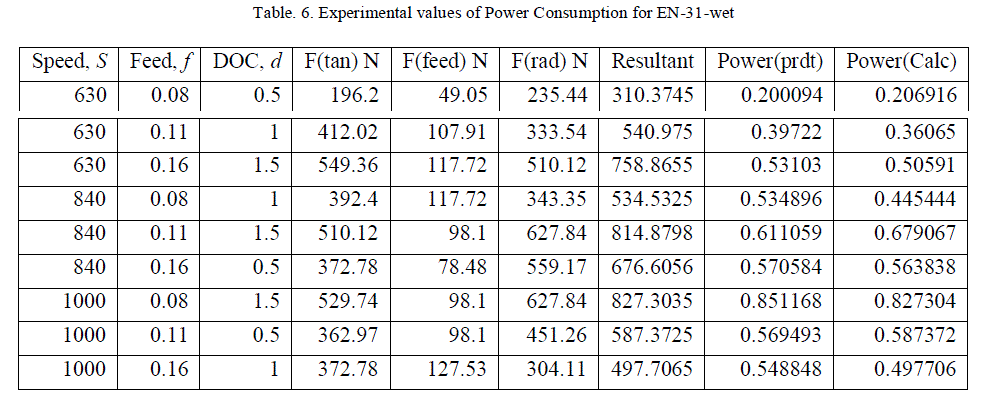 |
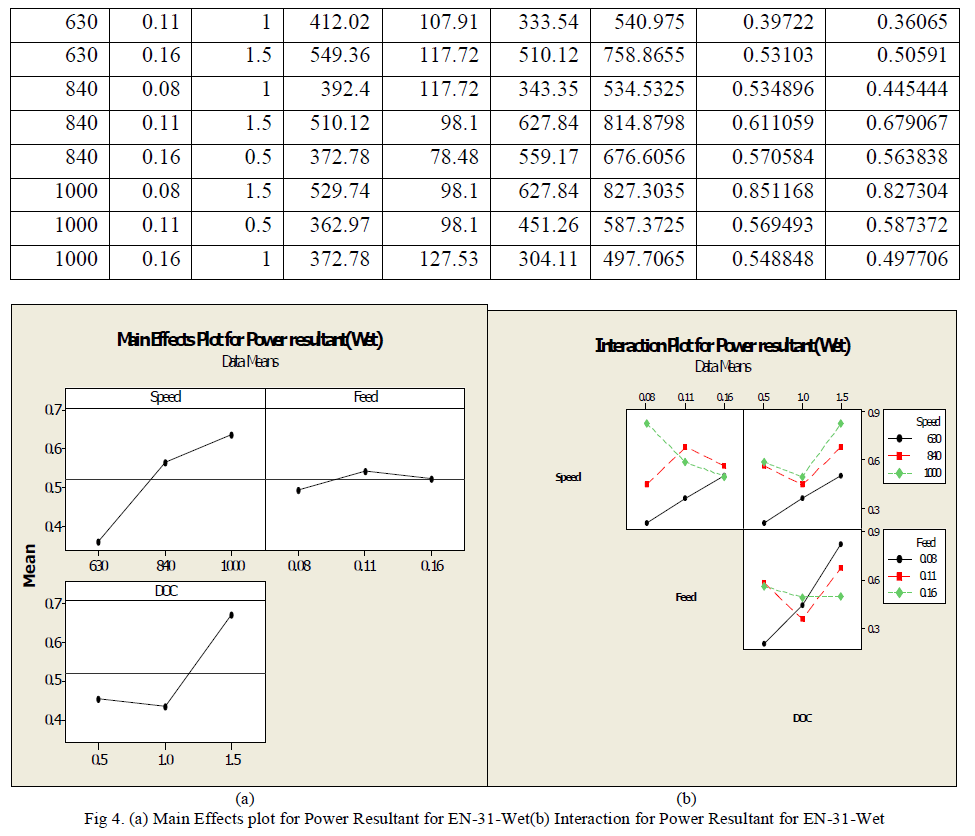 |
| Fig 4. (a) shows that the power consumption increases gradually with increase in speed. For feed rate it is fairly constant; it decreases slightly from DOC 0.5 to 1.0 and increases drastically from DOC 1.0 to 1.5 mm. Fig 4 (b) shows interaction plots for Speed v/s Feed, Speed v/s DOC, and Feed v/s DOC for EN-31-wet.At low speed the power consumption increases with increase in feed. At all speeds and high feed rates the power consumption remains fairly same. At high speed the power consumption decreases slightly with increase in feed from 0.08 to 0.11 and then decreases further for feed range 0.11 to 0.16.At low speed the power consumption increases with increase in DOC. At low and medium speed the power consumption graph shows same trend, the power consumption decreases slightly with increase in DOC and thereafter increases with increase in DOC. The unit variation in power consumption is observed to be uniform at all feeds and low and hence it is recommended to use medium DOC’s with various feed rates. Better Ra value is obtained at low speed and low DOC. |
| Predicted regression model for power consumption is |
| Power (prdt) wet= -1.7812 + 0.002121S +16.033f+0.322d -0.01486Sf -0.000208Sd -3.279fd + 0.016008 |
VI. COMPARISON OF POWER CONSUMPTION FOR EN-24 AND EN-31 |
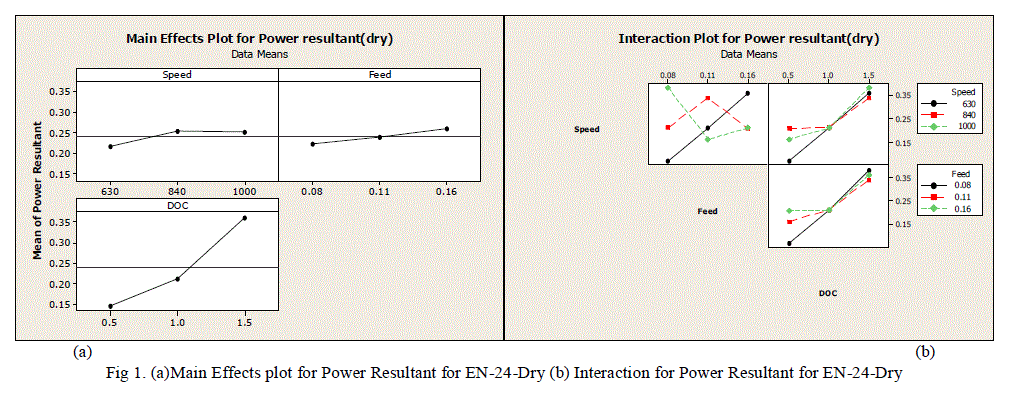 |
| Fig 5. (a) & (b) show that the results obtained are in 90% confidence level i.e. the predicted and the experimental values are close to each other. The nature of the graphs obtained by platting the results is shown in Fig 5 (a) and (b). The graphs are plotted in Microsoft Excel. The equations mentioned above can be used to predict the power consumption with good accuracy with the range. This has been confirmed by conducting conformation and validation experiments. The results may or may not yield the correct results beyond the range. |
VII. CONCLUSION |
| The predicted values and measured values are fairly close which indicates that the developed power consumption prediction models can be effectively used to predict the power consumption from the cutting process with 90% confident intervals for both case (dry and wet). Discarded engine oil of petrol car can be used as a lubricant to reduce the power consumption as it is observed that the surface roughness of materials under consideration also improves. However, its chemical effects on the material have to be studied. |
References |
|